-
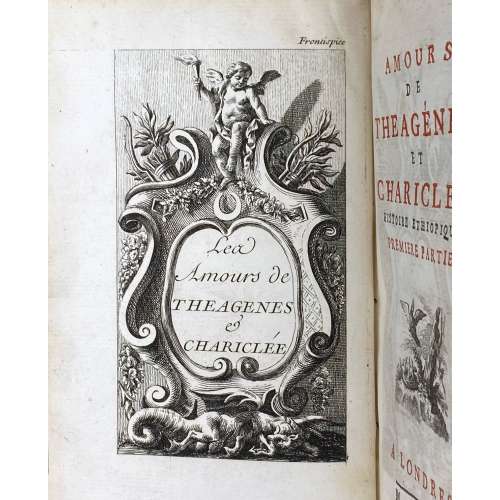 Two volumes in-16o, 16.3 x 10.3 cm, uniformly bound in marbled calf with gilt triple-fillet border, flat spine with gilt lozenges in compartments, two crimson labels with gilt lettering, marbled endpapers, all edges gilt, with engraved title, 2 title vignettes, 11 copper plate engravings, incl. title/frontispiece in vol. 1, and 10 headpieces (two of them similar), printed on laid paper. Vol. 1: Livres 1 – 5. Engraved title-page: Cartouche with the title "Les | Amours de | THEAGENES | & | CHARICLÉE", with a Cupid holding a torch on top and a defeated winged dragon at the bottom; Cupid's quivers with bows and arrows beside. Collation: 8vo; a5 (t.p., preface), A-N8 O4 (O4 blank), total 113 leaves plus 6 unsigned engraved plates, incl. engraved title as frontispiece, unsigned; 5 different headpieces, unsigned. Pagination: [i, ii] iii-x, [1] 2-213 [3] (blank), total 226 pages, ils. Vol. 2: Livres 6 – 10. Collation: 8vo; π1 (t.p.), A-M8, total 97 leaves plus 6 unsigned plates, incl. the Conclusion, no frontispiece; 5 headpieces, the headpiece for Livre 7 similar to Livre 4. Pagination: [2] [1] 2-190 [2] (blank), total 194 pages, ils. Letterpress title-page (red and black) in each volume: AMOURS | DE | THEAGÉNES | ET | CHARICLÉE• | HISTOIRE ETHIOPIQUE. | PREMIERE (SECONDE) PARTIE. | {vignette} | A LONDRES, | — | M. DCC. XLIII. || According to Cohen-DeRicci, this is the first anonymous edition with 9 different headpieces; the second edition in the same 1743 was published by Antoine Urban Coustelier (French, 1714 – 1763) in Paris with less provocative headpiece vignettes. The original text belongs to Héliodore d'Emèse, i.e. Heliodorus [Ἡλιόδωρος] (Greek, 3rd – 4th century AD). The earliest translation into French was performed by Jacques Amyot (French, 1513 – 1593) and published by J. Longis in Paris in 1547. The new translation is credited by Lewine to Jean de Montlyard (French/Swiss, 17th century), first published in Paris in 1620. However, most scholars attribute it to Louis François de Fontenu (French, 1667 – 1759), Bernard Le Bovier de Fontenelle (French, 1657 – 1757) or Germain François Poullain de Saint-Foix (French, 1698 – 1776), first published in 1727 by Herman Uytwerf (Dutch, 1698 – 1754) in Amsterdam. Catalogue raisonné : J. Lewine, 236; Cohen-DeRicci, 478. Information about the story can be found here: Aethiopica.
Two volumes in-16o, 16.3 x 10.3 cm, uniformly bound in marbled calf with gilt triple-fillet border, flat spine with gilt lozenges in compartments, two crimson labels with gilt lettering, marbled endpapers, all edges gilt, with engraved title, 2 title vignettes, 11 copper plate engravings, incl. title/frontispiece in vol. 1, and 10 headpieces (two of them similar), printed on laid paper. Vol. 1: Livres 1 – 5. Engraved title-page: Cartouche with the title "Les | Amours de | THEAGENES | & | CHARICLÉE", with a Cupid holding a torch on top and a defeated winged dragon at the bottom; Cupid's quivers with bows and arrows beside. Collation: 8vo; a5 (t.p., preface), A-N8 O4 (O4 blank), total 113 leaves plus 6 unsigned engraved plates, incl. engraved title as frontispiece, unsigned; 5 different headpieces, unsigned. Pagination: [i, ii] iii-x, [1] 2-213 [3] (blank), total 226 pages, ils. Vol. 2: Livres 6 – 10. Collation: 8vo; π1 (t.p.), A-M8, total 97 leaves plus 6 unsigned plates, incl. the Conclusion, no frontispiece; 5 headpieces, the headpiece for Livre 7 similar to Livre 4. Pagination: [2] [1] 2-190 [2] (blank), total 194 pages, ils. Letterpress title-page (red and black) in each volume: AMOURS | DE | THEAGÉNES | ET | CHARICLÉE• | HISTOIRE ETHIOPIQUE. | PREMIERE (SECONDE) PARTIE. | {vignette} | A LONDRES, | — | M. DCC. XLIII. || According to Cohen-DeRicci, this is the first anonymous edition with 9 different headpieces; the second edition in the same 1743 was published by Antoine Urban Coustelier (French, 1714 – 1763) in Paris with less provocative headpiece vignettes. The original text belongs to Héliodore d'Emèse, i.e. Heliodorus [Ἡλιόδωρος] (Greek, 3rd – 4th century AD). The earliest translation into French was performed by Jacques Amyot (French, 1513 – 1593) and published by J. Longis in Paris in 1547. The new translation is credited by Lewine to Jean de Montlyard (French/Swiss, 17th century), first published in Paris in 1620. However, most scholars attribute it to Louis François de Fontenu (French, 1667 – 1759), Bernard Le Bovier de Fontenelle (French, 1657 – 1757) or Germain François Poullain de Saint-Foix (French, 1698 – 1776), first published in 1727 by Herman Uytwerf (Dutch, 1698 – 1754) in Amsterdam. Catalogue raisonné : J. Lewine, 236; Cohen-DeRicci, 478. Information about the story can be found here: Aethiopica. -
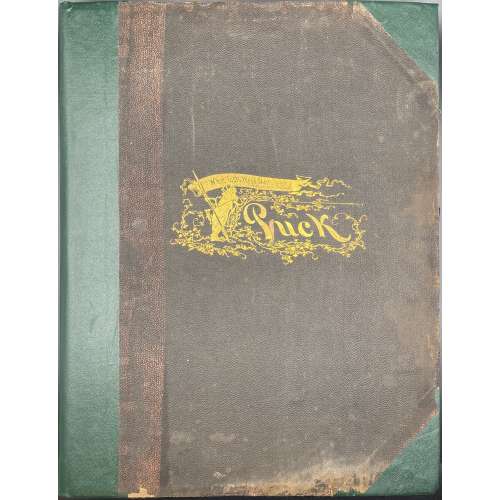 26 issues of American political humourous magazine published by Joseph Keppler (Austrian-American, 1838 – 1894) and Adolph Schwarzmann (German-American, 1838 – 1904) with caricatures by Frederick Burr Opper (American, 1857 – 1937); 35 x 27 cm, bound in faux shagreen with half green buckram backing, gilt vignette and lettering to front board: ‘What fools these Mortals be!” | MIDSUMMER NIGHT'S DREAM | PUCK ||
26 issues of American political humourous magazine published by Joseph Keppler (Austrian-American, 1838 – 1894) and Adolph Schwarzmann (German-American, 1838 – 1904) with caricatures by Frederick Burr Opper (American, 1857 – 1937); 35 x 27 cm, bound in faux shagreen with half green buckram backing, gilt vignette and lettering to front board: ‘What fools these Mortals be!” | MIDSUMMER NIGHT'S DREAM | PUCK || -
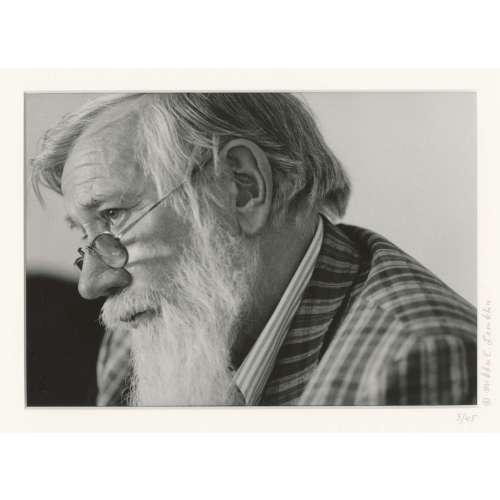 Photographic portrait of writer Andrei Sinyavsky, head and shoulder, turned to the left, wearing glasses. Pencil-signed on the mat: 3/45 • ©Mikhail Lemkhin; on the back of the print: Copyright statement stamp; ink stamp ©MIKHAIL LEMKHIN; ink stamp: PHOTO BY MIKHAIL LEMKHIN | 1811 38TH AVENUE | SAN FRANCISCO, CA 94122 | (415) 664-7677; pencil inscription on the back of the mat: (top) АНДРЕЙ СИНЯВСКИЙ | ANDREI SINYAVSKY, (bottom) XXIX. Sitter: Andrei Sinyavsky [Андрей Донатович Синявский] (Russian, 1925 – 1997) Size: mat: 35.6 x 43.3 cm; window: 16.5 x 23.5 cm; print: 20.2 x 25.2 cm.
Photographic portrait of writer Andrei Sinyavsky, head and shoulder, turned to the left, wearing glasses. Pencil-signed on the mat: 3/45 • ©Mikhail Lemkhin; on the back of the print: Copyright statement stamp; ink stamp ©MIKHAIL LEMKHIN; ink stamp: PHOTO BY MIKHAIL LEMKHIN | 1811 38TH AVENUE | SAN FRANCISCO, CA 94122 | (415) 664-7677; pencil inscription on the back of the mat: (top) АНДРЕЙ СИНЯВСКИЙ | ANDREI SINYAVSKY, (bottom) XXIX. Sitter: Andrei Sinyavsky [Андрей Донатович Синявский] (Russian, 1925 – 1997) Size: mat: 35.6 x 43.3 cm; window: 16.5 x 23.5 cm; print: 20.2 x 25.2 cm. -
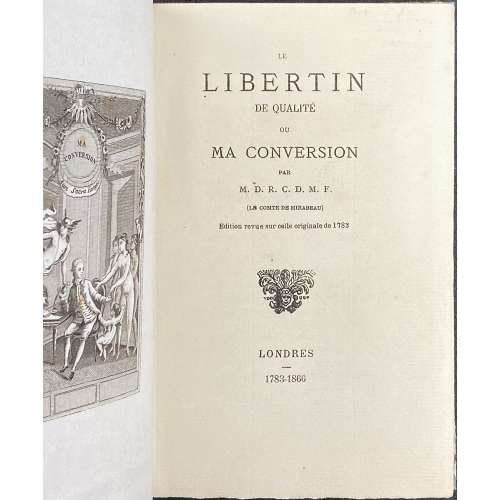 Hardcover volume, 17 x 11.3 cm, in-12, quarter orange cloth (percaline) over marbled boards, black morocco label with gilt lettering to spine, marbled endpapers, text printed on laid paper, five plates on India paper (papier Chine). Title-page: LE | LIBERTIN | DE QUALITÉ | OU | MA CONVERSION | PAR | M. D. R. C. D. M. F. | (LE COMTE DE MIRABEAU) | Edition revue sur celle originale de 1783 | {fleuron} | LONDRES | – | 1783-1866 || Pagination: [4] (h.t., t.p.), [1] 2-200; total 204 pages plus 5 engraved plates, incl. frontispiece; 2 blank leaves at the front and 2 at the back, laid paper, watermarked Canson & Montgolfier. Catalogue raisonné: Dutel I: A-653. Ref.: Illustrations were earlier published in Vie privée, libertine et scandaleuse de feu Honoré-Gabriel Riquetti Comte de Mirabeau, 1791, (see [LIB-2633.2021] Apollinaire, et al. L’Enfer de la Bibliothèque nationale, 1912 : № 795). M. D. R. C. D. M. F stands for Monsieur de Riqueti comte de Mirabeau Fis. Catalogue Poulet-Malassis & ses amis description: № 55. M. D. R. C. D. M. F. (le comte de Mirabeau). Le Libertin de qualité ou Ma conversion, édition revue sur celle de l’originale de 1783. Londres 1783-1866 [Christiaens, 1867]. In-12 de 2 .n.ch. et 200 pages, demi-percaline orange, pièce de titre, tête jaspée, tranches naturelles (reliure de l’époque). Illustré de 5 gravures originales, dont l’une en frontispice, qui reprennent celles de l’édition de Vie privée libertine et scandaleuse de feu Honoré-Gabriel-Riqueti, ci-devant comte de Mirabeau [...] de 1791. Contributors: Honoré-Gabriel Riqueti de Mirabeau (French, 1749 – 1791) – author. Alexis Christiaens (Belgian, d. 1880) – publisher.
Hardcover volume, 17 x 11.3 cm, in-12, quarter orange cloth (percaline) over marbled boards, black morocco label with gilt lettering to spine, marbled endpapers, text printed on laid paper, five plates on India paper (papier Chine). Title-page: LE | LIBERTIN | DE QUALITÉ | OU | MA CONVERSION | PAR | M. D. R. C. D. M. F. | (LE COMTE DE MIRABEAU) | Edition revue sur celle originale de 1783 | {fleuron} | LONDRES | – | 1783-1866 || Pagination: [4] (h.t., t.p.), [1] 2-200; total 204 pages plus 5 engraved plates, incl. frontispiece; 2 blank leaves at the front and 2 at the back, laid paper, watermarked Canson & Montgolfier. Catalogue raisonné: Dutel I: A-653. Ref.: Illustrations were earlier published in Vie privée, libertine et scandaleuse de feu Honoré-Gabriel Riquetti Comte de Mirabeau, 1791, (see [LIB-2633.2021] Apollinaire, et al. L’Enfer de la Bibliothèque nationale, 1912 : № 795). M. D. R. C. D. M. F stands for Monsieur de Riqueti comte de Mirabeau Fis. Catalogue Poulet-Malassis & ses amis description: № 55. M. D. R. C. D. M. F. (le comte de Mirabeau). Le Libertin de qualité ou Ma conversion, édition revue sur celle de l’originale de 1783. Londres 1783-1866 [Christiaens, 1867]. In-12 de 2 .n.ch. et 200 pages, demi-percaline orange, pièce de titre, tête jaspée, tranches naturelles (reliure de l’époque). Illustré de 5 gravures originales, dont l’une en frontispice, qui reprennent celles de l’édition de Vie privée libertine et scandaleuse de feu Honoré-Gabriel-Riqueti, ci-devant comte de Mirabeau [...] de 1791. Contributors: Honoré-Gabriel Riqueti de Mirabeau (French, 1749 – 1791) – author. Alexis Christiaens (Belgian, d. 1880) – publisher. -
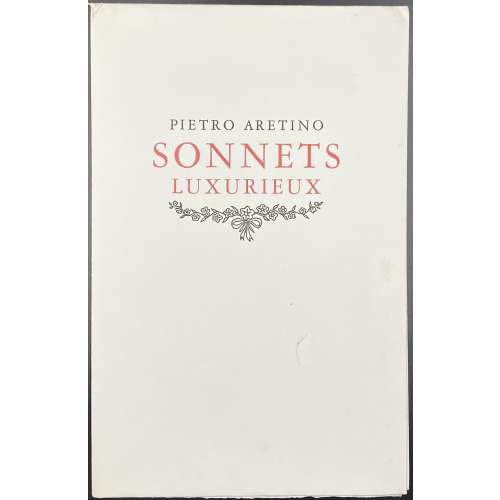 Softcover volume, 25.9 x 16.7 cm, in French flapped wrappers lettered "PIETRO ARETINO | SONNETS | LUXURIEUX | {garland}" unbound, 6 gatherings in 4to (24 leaves, incl. those in wrappers), a few sheets of guard tissue laid in, unpaginated, lower margin untrimmed; in a burgundy double slipcase 26.3 x 17.3 cm. Illustrated with title-page vignette, red initials and tailpieces and 16 half-page engravings by Jean Baptiste Tavy Notton. Text in Italian and French. Title-page (red and black): SONNETS | LUXURIEUX | de | PIETRO ARETINO | dit L'ARÉTIN | avec accompagnement | de gravures au burin | d'après la description des gravures | de GIULIO PIPPI DE GIANNUZZI dit JULES ROMAIN | {vignette} | AUX DÉPENS | DE QUELQUES AMATEURS | 1948 || Clandestine limited edition, print run of 250 copies, of which this is copy № 20, printed on thick wove paper without watermarks. Catalogue raisonné: Dutel III № 2421. Original edition: Sonetti lussuriosi by Pietro Aretino, illustrated by Giulio Romano and engraved by Marcantonio Raimondi, published clandestinely in Venice in c.1527. Contributors: Pietro Aretino (Italian, 1492 – 1556) – author. Jean Baptiste Tavy Notton (French, 1914 – 1971) – artist. Antoine-Isidore Liseux (French, 1835 – 1894) – translator/comments. Giulio Romano [Giulio Pippi, Giulio Giannuzzi] (Italian, c.1499 – 1546) – artist. Marcantonio Raimondi (Italian c. 1470/82 – c. 1534) – engraver.
Softcover volume, 25.9 x 16.7 cm, in French flapped wrappers lettered "PIETRO ARETINO | SONNETS | LUXURIEUX | {garland}" unbound, 6 gatherings in 4to (24 leaves, incl. those in wrappers), a few sheets of guard tissue laid in, unpaginated, lower margin untrimmed; in a burgundy double slipcase 26.3 x 17.3 cm. Illustrated with title-page vignette, red initials and tailpieces and 16 half-page engravings by Jean Baptiste Tavy Notton. Text in Italian and French. Title-page (red and black): SONNETS | LUXURIEUX | de | PIETRO ARETINO | dit L'ARÉTIN | avec accompagnement | de gravures au burin | d'après la description des gravures | de GIULIO PIPPI DE GIANNUZZI dit JULES ROMAIN | {vignette} | AUX DÉPENS | DE QUELQUES AMATEURS | 1948 || Clandestine limited edition, print run of 250 copies, of which this is copy № 20, printed on thick wove paper without watermarks. Catalogue raisonné: Dutel III № 2421. Original edition: Sonetti lussuriosi by Pietro Aretino, illustrated by Giulio Romano and engraved by Marcantonio Raimondi, published clandestinely in Venice in c.1527. Contributors: Pietro Aretino (Italian, 1492 – 1556) – author. Jean Baptiste Tavy Notton (French, 1914 – 1971) – artist. Antoine-Isidore Liseux (French, 1835 – 1894) – translator/comments. Giulio Romano [Giulio Pippi, Giulio Giannuzzi] (Italian, c.1499 – 1546) – artist. Marcantonio Raimondi (Italian c. 1470/82 – c. 1534) – engraver. -
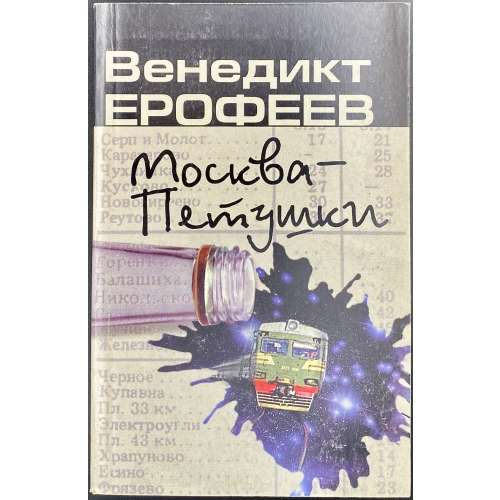 Paperback, 16.5 x 10.8 cm, pictorial wrappers, lettering to front and spine; pp.: [1-4] 5-187 [188] [4]. Title-page: Венедикт | ЕРОФЕЕВ | Москва – | Петушки | ПОЭМА | ВАГРИУС • МОСКВА • 2003 || Print-run: 11,000. Contributors: Венедикт Васильевич Ерофеев [Venedikt Yerofeyev] (Russian, 1938 – 1990) – author. Вагриус – publisher.
Paperback, 16.5 x 10.8 cm, pictorial wrappers, lettering to front and spine; pp.: [1-4] 5-187 [188] [4]. Title-page: Венедикт | ЕРОФЕЕВ | Москва – | Петушки | ПОЭМА | ВАГРИУС • МОСКВА • 2003 || Print-run: 11,000. Contributors: Венедикт Васильевич Ерофеев [Venedikt Yerofeyev] (Russian, 1938 – 1990) – author. Вагриус – publisher. -
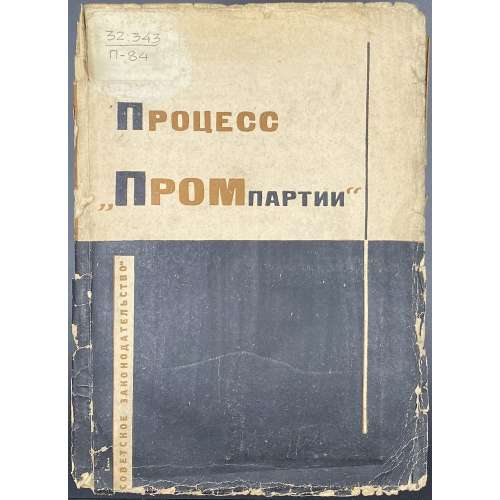 Softcover, 24 x 18 cm, black and white original wrappers, lettering; pp. [1-6] 7-541 [3]; purple ink library stamps and numbers. Title-page: ПРОЦЕСС “ПРОМПАРТИИ” | (25 ноября – 7 декабря 1930 г.) | СТЕНОГРАММА | СУДЕБНОГО ПРОЦЕССА | И МАТЕРИАЛЫ, | ПРИОБЩЕННЫЕ К ДЕЛУ | 1931 | ОГИЗ — “СОВЕТСКОЕ ЗАКОНОДАТЕЛЬСТВО” — МОСКВА || Процесс Промпартии [Industrial Party Trial] Андрей Януарьевич Вышинский [Andrey Vyshinsky] (Russian, 1883 – 1954) – chairman. Николай Васильевич Крыленко [Nikolai Krylenko] (Russian, 1885 – 1938) – public prosecutor.
Softcover, 24 x 18 cm, black and white original wrappers, lettering; pp. [1-6] 7-541 [3]; purple ink library stamps and numbers. Title-page: ПРОЦЕСС “ПРОМПАРТИИ” | (25 ноября – 7 декабря 1930 г.) | СТЕНОГРАММА | СУДЕБНОГО ПРОЦЕССА | И МАТЕРИАЛЫ, | ПРИОБЩЕННЫЕ К ДЕЛУ | 1931 | ОГИЗ — “СОВЕТСКОЕ ЗАКОНОДАТЕЛЬСТВО” — МОСКВА || Процесс Промпартии [Industrial Party Trial] Андрей Януарьевич Вышинский [Andrey Vyshinsky] (Russian, 1883 – 1954) – chairman. Николай Васильевич Крыленко [Nikolai Krylenko] (Russian, 1885 – 1938) – public prosecutor. -
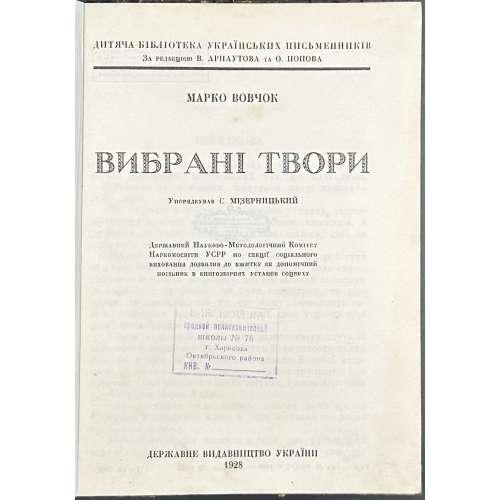 Owner’s quarter cloth over faux marbled paper binding, 19.8 x 15.1 cm, pp.: [1-4] 5-227 [3], total 230 pages plus frontispiece (b/w photographic portrait w/facsimile); library blue ink stamp to t.p. “Библиотека средней политехнической школы № 76 г. Харькова Октябрьского района Инв. № ___». Title-page: ДИТЯЧА БIБЛIОТЕКА УКРАЇНСЬКИХ ПИСЬМЕННИКIВ | За редакцiєю В. АРНАУТОВА та О. ПОПОВА | — | ВИБРАНI ТВОРИ | Упорядкував С. МIЗЕРНИЦЬКИЙ | Державний Науково-Методологiчний Комитет | Наркомосвiти УСРР по секциï сицiяльного | виховання дозволив до вжитку як допомiчний | посiбник в книгозбiрнях установ соцвиху | ДЕРЖАВНЕ ВИДАВНИЦТВО УКРАЇНИ | 1928 || Contents: Передмова, Викуп, Паньска воля (Горпина), Козачка, Ледащиця, Чумак, Не до пари, Тюлева баба, Кармелюк, Гайдамаки. Print run: 5,000 copies. Contributors: Марко Вовчок [Marko Vovchok; Марія Олександрівна Вілінська] (Ukrainian, 1833 – 1907) – author. Other variants: Markowovzok and Marko Vovtchok.
Owner’s quarter cloth over faux marbled paper binding, 19.8 x 15.1 cm, pp.: [1-4] 5-227 [3], total 230 pages plus frontispiece (b/w photographic portrait w/facsimile); library blue ink stamp to t.p. “Библиотека средней политехнической школы № 76 г. Харькова Октябрьского района Инв. № ___». Title-page: ДИТЯЧА БIБЛIОТЕКА УКРАЇНСЬКИХ ПИСЬМЕННИКIВ | За редакцiєю В. АРНАУТОВА та О. ПОПОВА | — | ВИБРАНI ТВОРИ | Упорядкував С. МIЗЕРНИЦЬКИЙ | Державний Науково-Методологiчний Комитет | Наркомосвiти УСРР по секциï сицiяльного | виховання дозволив до вжитку як допомiчний | посiбник в книгозбiрнях установ соцвиху | ДЕРЖАВНЕ ВИДАВНИЦТВО УКРАЇНИ | 1928 || Contents: Передмова, Викуп, Паньска воля (Горпина), Козачка, Ледащиця, Чумак, Не до пари, Тюлева баба, Кармелюк, Гайдамаки. Print run: 5,000 copies. Contributors: Марко Вовчок [Marko Vovchok; Марія Олександрівна Вілінська] (Ukrainian, 1833 – 1907) – author. Other variants: Markowovzok and Marko Vovtchok. -
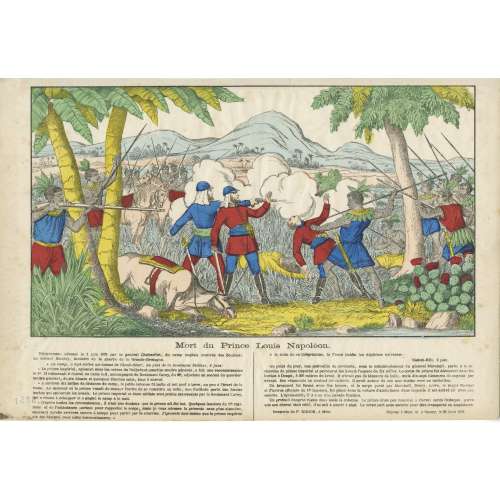 Hand-coloured woodcut on wove paper, 267 x 390 mm. On reverse: black ink stamp “5351”. Centre, under the image frame "Mort du Prince Louis Napoléon". Below left: "Télégramme adressé le 2 juin 1879 par le général Chelmsfort, du camp anglais (contrée des Zoulous), au colonel Stanley, ministre de la guerre de la Grande-Bretagne. « Au camp, à sept milles au-dessus de Blood-River, au pied de la montagne Stellezi, 2 juin: Le prince impérial, agissant sous les ordres de l'adjudant quartier-maitre général. a fait une reconnaissance le 1er. Il retournait à cheval au camp le 2 accompagné du lieutenant Carey, du 98e adjudant en second du quartier-maitre général. de six blancs et, quelques Zoulous amis, tous à cheval. A environ dix milles de distance du camp, la petite colonne fit halte at mit pied à terre, un peu à l’écart de la route. Au moment ou le prince venait de donner l'ordre de se remettre en selle. une fusillade partit des hautes herbes qui entourant les kraals. Le prince impérial et deux soldats sont portés manquants par le lieutenant Carey, qui a réussi à échapper et a gagné le camp à la nuit. D'après toutes les circonstances, il 'est pas douteux quo le prince ait été tué. Quelques lanciers du 17 régiment et de l'ambulance partent pour rapporter le corps; mais je vous adresse la présente sans plus attendre, espérant qu'elle arrivera encore à temps pour partir par le courrier. J’ignorais moi-même que le prince impérial eût été désigné pour cette reconnaissance. »" Below right: A la suite de le télégramme, le Times publie les dépêches suivantes: Stelezi-Hill, 2 juin. Au point du jour, une patrouille de cavalerie, sous le commandement du général Marshall. partit à la recherche du prince impérial et parcourut les kraals l'espace de dix milles. Le corps du prince fut découvert dans les herbes à Donga, à 300 mètres du kraal. Il n'avait pas de blessure de balle, mais dix-sept blessures de zagaies par devant. Ses vêtements lui avaient été enlevés. I avait autour du cou une chaine avec un médaillon. Un brancard fut formé avec les lances, et le corps porté par Marchall, Drury, Lowe, le mjor Stewart et d'autres officiers du 17e lanciers, fut. place dans la voiture d'ambulance dans laquelle il est arrivé ici avec une escorte. L'après-midi, il v a eu une parade funèbre. Un profond chagrin règne dans toute la colonne. Le prince n'est pas remonté à cheval après l’attique, parce que son cheval était rétif ; il se mit à courir à pied. Le corps part sous escorte pour être transporté en Angleterre. Bottom right: "Imagerie de P. DIDION, à Metz — Déposé à Metz et à Nancy, le 25 Juin 1879". Paulin Didion (French, 1831 – 1879) – publisher/printer.
Hand-coloured woodcut on wove paper, 267 x 390 mm. On reverse: black ink stamp “5351”. Centre, under the image frame "Mort du Prince Louis Napoléon". Below left: "Télégramme adressé le 2 juin 1879 par le général Chelmsfort, du camp anglais (contrée des Zoulous), au colonel Stanley, ministre de la guerre de la Grande-Bretagne. « Au camp, à sept milles au-dessus de Blood-River, au pied de la montagne Stellezi, 2 juin: Le prince impérial, agissant sous les ordres de l'adjudant quartier-maitre général. a fait une reconnaissance le 1er. Il retournait à cheval au camp le 2 accompagné du lieutenant Carey, du 98e adjudant en second du quartier-maitre général. de six blancs et, quelques Zoulous amis, tous à cheval. A environ dix milles de distance du camp, la petite colonne fit halte at mit pied à terre, un peu à l’écart de la route. Au moment ou le prince venait de donner l'ordre de se remettre en selle. une fusillade partit des hautes herbes qui entourant les kraals. Le prince impérial et deux soldats sont portés manquants par le lieutenant Carey, qui a réussi à échapper et a gagné le camp à la nuit. D'après toutes les circonstances, il 'est pas douteux quo le prince ait été tué. Quelques lanciers du 17 régiment et de l'ambulance partent pour rapporter le corps; mais je vous adresse la présente sans plus attendre, espérant qu'elle arrivera encore à temps pour partir par le courrier. J’ignorais moi-même que le prince impérial eût été désigné pour cette reconnaissance. »" Below right: A la suite de le télégramme, le Times publie les dépêches suivantes: Stelezi-Hill, 2 juin. Au point du jour, une patrouille de cavalerie, sous le commandement du général Marshall. partit à la recherche du prince impérial et parcourut les kraals l'espace de dix milles. Le corps du prince fut découvert dans les herbes à Donga, à 300 mètres du kraal. Il n'avait pas de blessure de balle, mais dix-sept blessures de zagaies par devant. Ses vêtements lui avaient été enlevés. I avait autour du cou une chaine avec un médaillon. Un brancard fut formé avec les lances, et le corps porté par Marchall, Drury, Lowe, le mjor Stewart et d'autres officiers du 17e lanciers, fut. place dans la voiture d'ambulance dans laquelle il est arrivé ici avec une escorte. L'après-midi, il v a eu une parade funèbre. Un profond chagrin règne dans toute la colonne. Le prince n'est pas remonté à cheval après l’attique, parce que son cheval était rétif ; il se mit à courir à pied. Le corps part sous escorte pour être transporté en Angleterre. Bottom right: "Imagerie de P. DIDION, à Metz — Déposé à Metz et à Nancy, le 25 Juin 1879". Paulin Didion (French, 1831 – 1879) – publisher/printer. -
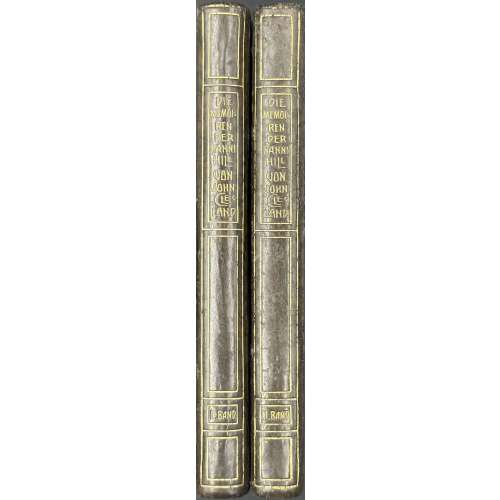 Two hardcover volumes, 17 x 11.5 cm, collated in-8vo, uniformly bound in dark grey mottled calf bordered with gilt fillet, flat spine with gilt lettering in compartments outlined in gilt; top edge gilt, text and plates printed on dense wove paper (Japanpapier). Privately printed by Gustav Röttig & Sohn (Ödenburg) in 800 copies, of which this is copy № 16, signed by von Bayros in 1st vol. Each volume is illustrated with four heliogravures (title-page and three plates) after drawings by Franz von Bayros. According to the seller, this is one of only 35 copies of the deluxe edition on Japanpapier, a fact which was mentioned by the bibliographers but not in the imprint. Bookplate to front pastedown in each volume, lettering to bottom “Ex libris Dr. phil. Rudolf Ludwig”, 120 x 100 mm, heliogravure after von Bayros. Pp.: vol. 1 [4] 1-198 plus engraved t.p. and 3 plates. Vol. 2: 1-204 [2] plus engraved t.p. and 3 plates. Title-page: DIE MEMOIREN | DER | FANNY HILL | VON | JOHN CLELAND | ESTER (ZWEITER) BAND | PAPHOS IM JAHR DER | CYTHERE | MDCCCCVI || Author of the text: John Cleland (British, c. 1709 – 1789). Translator: Franz Blei [Dr. Erich Feldhammer] (Austrian, 1871 – 1942). Illustrator: Franz von Bayros (Austrian, 1866 – 1924). Provenance: Dr. Phil. Rudolf Ludwig. Catalogue raisonné: The amorous drawings of the Marquis von Bayros. — New York: Cythera Press, 1968. The Beautiful Maiden of Pao, pp. 31-38. Seller's Description: Erster [und] Zweiter Band. Paphos [Wien, C. W. Stern], im Jahr der Cythere 1906. Mit sechs Tafeln und zwei illustrierten Titeln nach Franz von Bayros, alle zweifarbig. Grau marmorierte Originalkalblederbände mit Rücken-, Deckelkanten- und Kopfschnittvergoldung. Privatdruck. – Eins von 35 Exemplaren der Luxusausgabe auf Japanpapier, im Druckvermerk von Band I von Bayros signiert. – Die Übersetzung stammt von Franz Blei, der hier unter dem Pseudonym Dr. Erich Feldhammer genannt wird. Als Textvorlage diente die Ausgabe London 1749. – Gedruckt wurde bei Gustav Röttig & Sohn in Ödenburg. – Sehr seltene Vorzugsausgabe, die zwar bei den Bibliographen, nicht aber im Druckvermerk genannt wurde. – Fast tadellos. – »Dieses Werk ist eines der berühmtesten in der erotischen Literatur« (Stern-Szana). Nach Hinweis bei Brettschneider wurde die Auflage beschlagnahmt. – Exlibris Dr. phil. Rudolf Ludwig, Wien (Heliogravüre nach Zeichnung von Franz von Bayros, Brettschneider 156) in beiden Bänden. 17 : 11,5 cm. [4], 198, [2], [4], 204, [2] Seiten. Zusammen 8 Tafeln. Brettschneider 38. – Hayn/Gotendorf I, 618. – Stern-Szana 243 und ausführlich S. 222ff
Two hardcover volumes, 17 x 11.5 cm, collated in-8vo, uniformly bound in dark grey mottled calf bordered with gilt fillet, flat spine with gilt lettering in compartments outlined in gilt; top edge gilt, text and plates printed on dense wove paper (Japanpapier). Privately printed by Gustav Röttig & Sohn (Ödenburg) in 800 copies, of which this is copy № 16, signed by von Bayros in 1st vol. Each volume is illustrated with four heliogravures (title-page and three plates) after drawings by Franz von Bayros. According to the seller, this is one of only 35 copies of the deluxe edition on Japanpapier, a fact which was mentioned by the bibliographers but not in the imprint. Bookplate to front pastedown in each volume, lettering to bottom “Ex libris Dr. phil. Rudolf Ludwig”, 120 x 100 mm, heliogravure after von Bayros. Pp.: vol. 1 [4] 1-198 plus engraved t.p. and 3 plates. Vol. 2: 1-204 [2] plus engraved t.p. and 3 plates. Title-page: DIE MEMOIREN | DER | FANNY HILL | VON | JOHN CLELAND | ESTER (ZWEITER) BAND | PAPHOS IM JAHR DER | CYTHERE | MDCCCCVI || Author of the text: John Cleland (British, c. 1709 – 1789). Translator: Franz Blei [Dr. Erich Feldhammer] (Austrian, 1871 – 1942). Illustrator: Franz von Bayros (Austrian, 1866 – 1924). Provenance: Dr. Phil. Rudolf Ludwig. Catalogue raisonné: The amorous drawings of the Marquis von Bayros. — New York: Cythera Press, 1968. The Beautiful Maiden of Pao, pp. 31-38. Seller's Description: Erster [und] Zweiter Band. Paphos [Wien, C. W. Stern], im Jahr der Cythere 1906. Mit sechs Tafeln und zwei illustrierten Titeln nach Franz von Bayros, alle zweifarbig. Grau marmorierte Originalkalblederbände mit Rücken-, Deckelkanten- und Kopfschnittvergoldung. Privatdruck. – Eins von 35 Exemplaren der Luxusausgabe auf Japanpapier, im Druckvermerk von Band I von Bayros signiert. – Die Übersetzung stammt von Franz Blei, der hier unter dem Pseudonym Dr. Erich Feldhammer genannt wird. Als Textvorlage diente die Ausgabe London 1749. – Gedruckt wurde bei Gustav Röttig & Sohn in Ödenburg. – Sehr seltene Vorzugsausgabe, die zwar bei den Bibliographen, nicht aber im Druckvermerk genannt wurde. – Fast tadellos. – »Dieses Werk ist eines der berühmtesten in der erotischen Literatur« (Stern-Szana). Nach Hinweis bei Brettschneider wurde die Auflage beschlagnahmt. – Exlibris Dr. phil. Rudolf Ludwig, Wien (Heliogravüre nach Zeichnung von Franz von Bayros, Brettschneider 156) in beiden Bänden. 17 : 11,5 cm. [4], 198, [2], [4], 204, [2] Seiten. Zusammen 8 Tafeln. Brettschneider 38. – Hayn/Gotendorf I, 618. – Stern-Szana 243 und ausführlich S. 222ff -
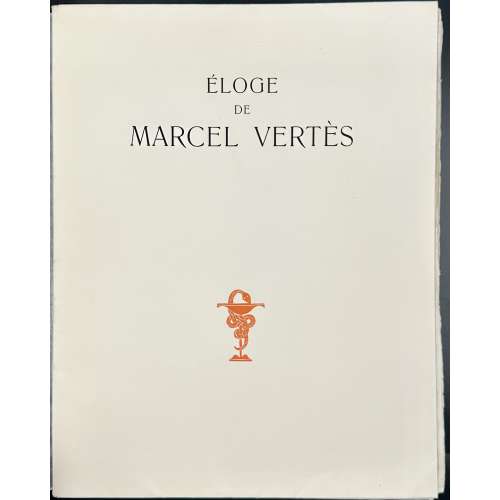 Softcover, 325 x 253 mm, publisher’s French flapped wrappers in glassine dust cover, 15 leaves folio folded in half, making 30 in-2o leaves 321 x 250 mm, with two leaves within the wrappers, [1] t.p., [2] Vertès’ blue ink inscription “À Alexaner Sternberg frère Nicolas qui est un garçon charmant et un bon artiste. Vertès.” and drawing, [3] frontispiece, [4-26] text with six full-page, one head- and one tailpiece in dry point technique, with guard tissues, [27] list of plates, [28] colophon, [29] blank; some page numbers manually scripted in pencil to the bottom right corners by a previous owner. Paper watermarked “BFK Rives”. Title-page (in orange and black): ÉLOGE | DE | MARCEL VERTÈS | PAR | GEORGES HUISMAN | ORNÉ | DE GRAVURES ORIGINALES | {publisher’s device} | MANUEL BRUKER ÉDITEUR || Colophon: CET OUVRAGE A ÉTÉ ACHEVÉ D'IMPRIMER SUR LES PRESSES DE L'IMPRIMERIE DARAGNÈS LE 30 OCTOBRE 1951 A 200 EXEMPLAIRES NUMÉROTÉS DONT 20 SUR VÉLIN 'ARCHES DE 1 A 20 AUXQUELS IL A ÉTÉ JOINT UNE SUITE DES GRAVURES SUR JAPON NACRÉ ET 180 SUR VÉLIN BLANC DE RIVES DE 21 A 200. ON A TIRÉ EN OUTRE 20 SUITES SUR MALACCA DES PLANCHES REFUSÉES. EXEMPLAIRE N° 93. Limitation: 200 copies printed on October 30, 1951, at Daragnès press: 20 (№№ 1-20) on Arches vellum paper with a suite of plates on Japon Nacré and 180 (№№ 21-200) Vélin Blanc by Rives. This is copy № 93. Tipped in: (1) photo of Vertès (and one more) in front of his murals, with the blue ballpoint pen inscription “À Alex Sternberg, frère de Nicola, excellent ami, excellent artiste et voyez, quel photographe!!! Vertès”; (2) postcard with a signed invitation to Vertès' exhibition by Librairie M.-P. Tremois: “Carte Postale | Paris, le 2 mars [19]28 | Monsieur, | Du 6 au 24 mars, | de 2 heures à 6h30, aura | lieu à la Librairie M.-P. Trémois | 43 avenue Rapp, 7e, une | exposition de dessins et | aquarelles de Vertès, ayant | servi à l’illustration de livres. | Nous espérons que vous | voudrez bien nous honorer | de votre visite. M.-P. Trémois.” The drypoint technique is confirmed by the presence of a white line in the middle of the black printed line on the micro photo:
Softcover, 325 x 253 mm, publisher’s French flapped wrappers in glassine dust cover, 15 leaves folio folded in half, making 30 in-2o leaves 321 x 250 mm, with two leaves within the wrappers, [1] t.p., [2] Vertès’ blue ink inscription “À Alexaner Sternberg frère Nicolas qui est un garçon charmant et un bon artiste. Vertès.” and drawing, [3] frontispiece, [4-26] text with six full-page, one head- and one tailpiece in dry point technique, with guard tissues, [27] list of plates, [28] colophon, [29] blank; some page numbers manually scripted in pencil to the bottom right corners by a previous owner. Paper watermarked “BFK Rives”. Title-page (in orange and black): ÉLOGE | DE | MARCEL VERTÈS | PAR | GEORGES HUISMAN | ORNÉ | DE GRAVURES ORIGINALES | {publisher’s device} | MANUEL BRUKER ÉDITEUR || Colophon: CET OUVRAGE A ÉTÉ ACHEVÉ D'IMPRIMER SUR LES PRESSES DE L'IMPRIMERIE DARAGNÈS LE 30 OCTOBRE 1951 A 200 EXEMPLAIRES NUMÉROTÉS DONT 20 SUR VÉLIN 'ARCHES DE 1 A 20 AUXQUELS IL A ÉTÉ JOINT UNE SUITE DES GRAVURES SUR JAPON NACRÉ ET 180 SUR VÉLIN BLANC DE RIVES DE 21 A 200. ON A TIRÉ EN OUTRE 20 SUITES SUR MALACCA DES PLANCHES REFUSÉES. EXEMPLAIRE N° 93. Limitation: 200 copies printed on October 30, 1951, at Daragnès press: 20 (№№ 1-20) on Arches vellum paper with a suite of plates on Japon Nacré and 180 (№№ 21-200) Vélin Blanc by Rives. This is copy № 93. Tipped in: (1) photo of Vertès (and one more) in front of his murals, with the blue ballpoint pen inscription “À Alex Sternberg, frère de Nicola, excellent ami, excellent artiste et voyez, quel photographe!!! Vertès”; (2) postcard with a signed invitation to Vertès' exhibition by Librairie M.-P. Tremois: “Carte Postale | Paris, le 2 mars [19]28 | Monsieur, | Du 6 au 24 mars, | de 2 heures à 6h30, aura | lieu à la Librairie M.-P. Trémois | 43 avenue Rapp, 7e, une | exposition de dessins et | aquarelles de Vertès, ayant | servi à l’illustration de livres. | Nous espérons que vous | voudrez bien nous honorer | de votre visite. M.-P. Trémois.” The drypoint technique is confirmed by the presence of a white line in the middle of the black printed line on the micro photo: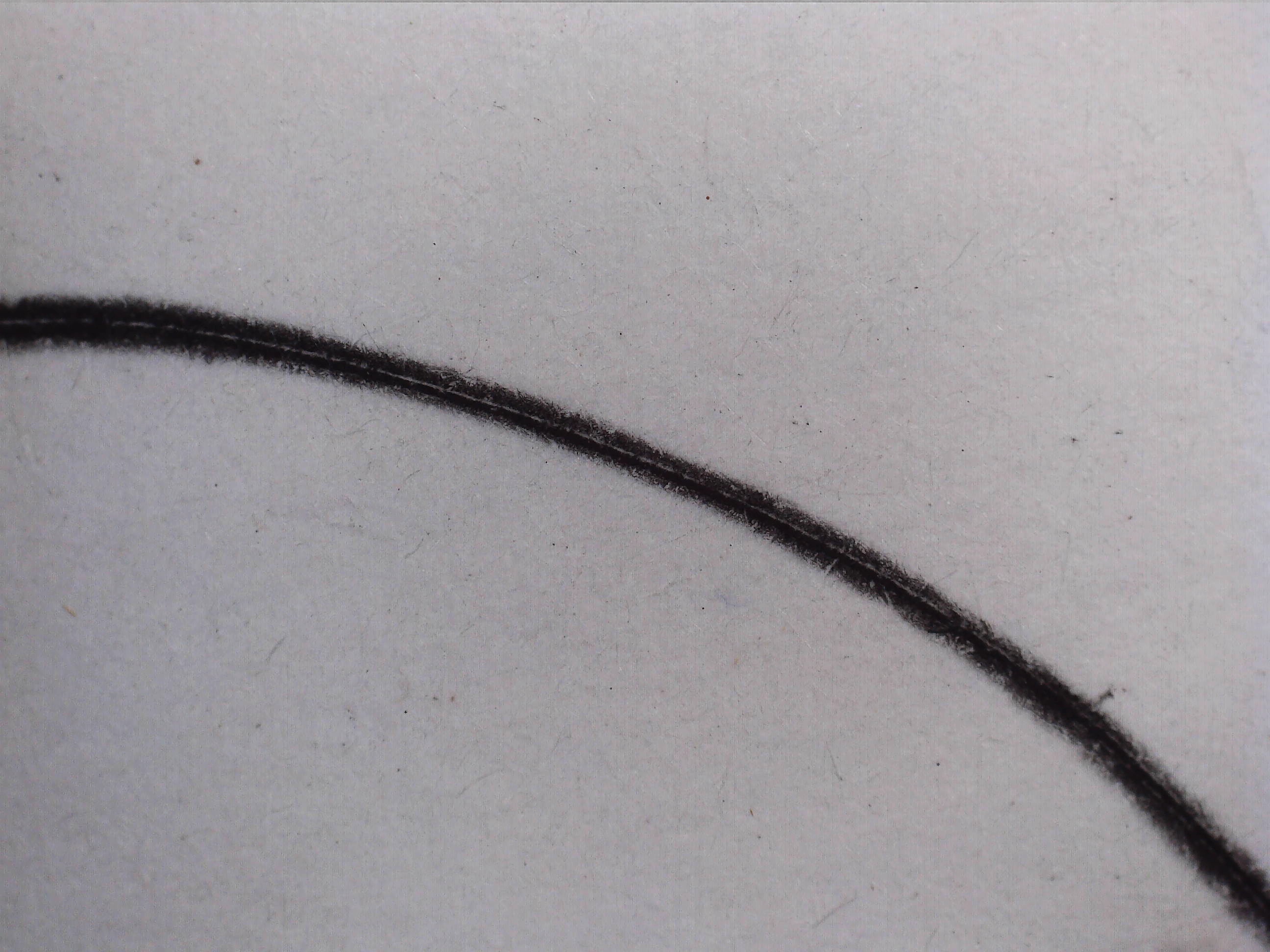 Catalogue raisonné: Vokaer № 52.
Contributors:
Georges Huisman (French, 1889 – 1957) – author.
Marcel Vertès [Marcell Vértes] (Jewish-Hungarian-French, 1895 – 1961) – character/artist.
Manuel Bruker (French, 1891 – 1979) – publisher.
Jean-Gabriel Daragnès (French, 1886 – 1950) – printer.
Nicolas Sternberg (Hungarian-French, 1902 –1960)
Librairie M.-P. Trémois (1925 – 1953)
Catalogue raisonné: Vokaer № 52.
Contributors:
Georges Huisman (French, 1889 – 1957) – author.
Marcel Vertès [Marcell Vértes] (Jewish-Hungarian-French, 1895 – 1961) – character/artist.
Manuel Bruker (French, 1891 – 1979) – publisher.
Jean-Gabriel Daragnès (French, 1886 – 1950) – printer.
Nicolas Sternberg (Hungarian-French, 1902 –1960)
Librairie M.-P. Trémois (1925 – 1953) -
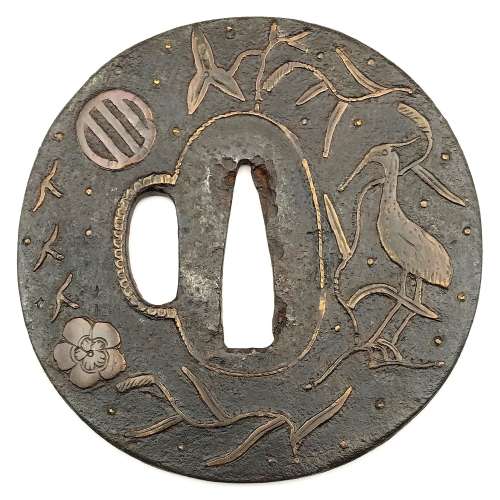 Iron tsuba of round form profusely decorated with brass inlay of plants, birds, well, and family crests (mon) in suemon-zōgan technique and occasional brass dots (nail-heads) or ten-zōgan. Seppa-dai and kozuka-hitsu-ana outlined with brass inaly, possibly repaired: rope-shaped wire here and there replaced with flat wire. The plate is very thin, with remnants of lacquer. Ōnin school. Size: 75.8 x 75.2 x 2.3 mm. Weight: 77.5 g. On the front side (omote) motif includes the following elements (from 12 o'clock, clockwise):
Iron tsuba of round form profusely decorated with brass inlay of plants, birds, well, and family crests (mon) in suemon-zōgan technique and occasional brass dots (nail-heads) or ten-zōgan. Seppa-dai and kozuka-hitsu-ana outlined with brass inaly, possibly repaired: rope-shaped wire here and there replaced with flat wire. The plate is very thin, with remnants of lacquer. Ōnin school. Size: 75.8 x 75.2 x 2.3 mm. Weight: 77.5 g. On the front side (omote) motif includes the following elements (from 12 o'clock, clockwise):- Water plantain (a.k.a. arrowhead, or omodaka): "a perpetual plant of the water plantain family, was also called shōgunsō (victorious army grass). Because of this martial connotation, it was a design favored for the crests of samurai families" [see: Family Crests of Japan. // Stone Bridge Press, Berkeley, CA, 2007; p. 63].
- Heron (sagi): "...considered an emblem of longevity, and from China comes the practice of regarding the bird as a mount of the gods and the Taoist sennin. [...] heron also reflects an inauspicious connotation, for the word sagi is homophone for 'fraud' and 'false pretenses'." [see: Merrily Baird. Symbols of Japan. Thematic motifs in art and design. // Rizzoli international publications, Inc., 2001; p. 112]. Some may say, that this is not a heron but a crane (tsuru). It's very possible, and in this case the negative connotation is lost, but the reference to longevity and allusion to sennin remain.
- Pampas grass (susuki, or obana): as per Merrily Baird, p. 95 and John W. Dower, p. 66, pampas grass is one of the Seven Grasses of Autumn. When combined with flying wild gees, conveys strong autumnal mood.
- Plum blossom (ume): according to Merrily Baird, the flower has a vast variety of symbolic meanings, including longevity, and a reference to the Chinese Taoists. It is used in 80 family crests [see: Japanese Design Motifs: 4,260 Illustrations of Japanese Crests; Compiled by the Matsuya Piece-Goods Store; Translated by Fumie Adachi. // Dover Publications, Inc., 1972.] Plum is "celebrated for its sweet perfume, delicate blossoms, and habit of blooming at the end of winter".
- Tree flying wild geese (kari): "Wild geese arrive in large flocks in southern regions during the autumn months, and following their migratory instincts, head back north in spring" [Family Crests of Japan, pp. 85-86]. "The importance of geese in Japanese art was further secured by stories of several military heroes who had achieved victory in battle when a sudden breaking of ranks by flying geese signaled an ambush. The protective role of the birds led to their frequent use in decorating sword furnishings and possibly also their adoption as a family crest motif.Finally, the goose in Asia plays a role in religious traditions" [Merrily Baird, pp.111-112].
- Hikiryō (line, or bar, or stripe) - a symbol which consists of one, two, or three horizontal or vertical stripes in a circle. "In wartime, Japanese generals [...] surrounded their encampments with huge cloth curtains. Usually these were made of cloth sewn together horizontally and varying in color [...] to distinguish the individual general and his followers. The stripe thus assumed strong martial connotations, and became a mark of identification on personal military gear as well. In the early fourteenth century the heads of the Ashikaga and Nitta, then the two most powerful clans in Japan, both adopted stripe patterns as a family crest". [See: Family Crests of Japan, p. 111 and John W. Dower. The elements of Japanese design - A handbook of family crests, heraldry & symbolism. // Weatherhill, New York, Tokyo, 1985, p. 144].
- Hikiryō, see above.
- Pampas grass (susuki, or obana), see above.
- Bellflower (kikyo): One of the Seven Grasses of Autumn. "As a crest, it have been adopted among the warriors around the thirteenth century, primarily because of it's beauty" [John W. Dower, p. 48].
- Four flying wild geese (kari), see above.
- Weeping willow (yanagi): "It is commonly represented with water, snow, swallows, or herons. A branch of willow (yoshi) is one of the attributes of the Buddhist deity Senju Kannon (Thousand-Armed Kannon), who is said to use the branch to sprinkle the nectar of life contained in a vase. [Merrily Baird, pp. 66-67].
- Lone plum blossom in a well frame/crib (igeta, izitsu): "Well crib was one of the most popular motifs in Japanese heraldry". As a crest it may stay simply for the first character (i) of the family name, however, with a flower inside the well frame, and together with the other symbols present, it may aggravate the sense of autumn-ness. The ten-zōgan dots in this particular case may represent the snowflakes or autumn stars.
-

Bertrand Russell. A history of western philosophy. A Touchstone Book. Published by Symon & Schuster, 2007. [Reprint 1945].
ISBN-10: 1-4165-5477-7
ISBN-13: 978-4165-5477-6.
-
 Bando Mitsugorō III as Lady Iwafuji and Nakamura Matsue III as Lady Onoe, 1821.「局岩ふじ 坂東三津五郎」(三代)、「中老尾上 中村松江」(三代) in kabuki play Kagamiyama Kokyô no Nishikie [鏡山旧錦繪] (Mirror mountain: A women’s treasury of loyalty); author: Yô Yôdai. Artist: Shunkōsai Hokushū (春好斎 北洲), who is also known as Shunkō IV, active from about 1802 to 1832. Actors: Bandō Mitsugorō III [三代目 坂東 三津五郎] (Japanese, 1775 – 1831); other names: Bandō Minosuke I, Morita Kanjirô II, Bandō Mitahachi I, Bandō Minosuke I, Bandō Mitahachi I. Nakamura Matsue III [三代目中村松江] (Japanese, 1786-1855); other names: Nakamura Sankō I, Nakamura Tomijūrō II, Ichikawa Kumatarō. Year: 1821 (Bunsei 4), 1st month. Publisher: Wataya Kihei (Wataki) (Japanese, fl. c. 1809 – 1885) Signed Shunkôsai Hokushû ga 春好斎北洲画. MFA Accession № 11.35375. MFA description: "Play: Keisei Kagamiyama (Mirror Mountain, a Courtesan Play). Theatre: Kado けいせい双鏡山(けいせいかがみやま)角. Ref.: [LIB-1193.2013] Leiter. Kabuki Encyclopedia, p. 156; [LIB-0879-2.2015] Kabuki plays on stage (vol. 2): 1773-1799, pp. 172-212.
Bando Mitsugorō III as Lady Iwafuji and Nakamura Matsue III as Lady Onoe, 1821.「局岩ふじ 坂東三津五郎」(三代)、「中老尾上 中村松江」(三代) in kabuki play Kagamiyama Kokyô no Nishikie [鏡山旧錦繪] (Mirror mountain: A women’s treasury of loyalty); author: Yô Yôdai. Artist: Shunkōsai Hokushū (春好斎 北洲), who is also known as Shunkō IV, active from about 1802 to 1832. Actors: Bandō Mitsugorō III [三代目 坂東 三津五郎] (Japanese, 1775 – 1831); other names: Bandō Minosuke I, Morita Kanjirô II, Bandō Mitahachi I, Bandō Minosuke I, Bandō Mitahachi I. Nakamura Matsue III [三代目中村松江] (Japanese, 1786-1855); other names: Nakamura Sankō I, Nakamura Tomijūrō II, Ichikawa Kumatarō. Year: 1821 (Bunsei 4), 1st month. Publisher: Wataya Kihei (Wataki) (Japanese, fl. c. 1809 – 1885) Signed Shunkôsai Hokushû ga 春好斎北洲画. MFA Accession № 11.35375. MFA description: "Play: Keisei Kagamiyama (Mirror Mountain, a Courtesan Play). Theatre: Kado けいせい双鏡山(けいせいかがみやま)角. Ref.: [LIB-1193.2013] Leiter. Kabuki Encyclopedia, p. 156; [LIB-0879-2.2015] Kabuki plays on stage (vol. 2): 1773-1799, pp. 172-212. -
 Iron tsuba of round form with design of military commander's fan (gunbai) in openwork (sukashi). Square rim. Hitsu-ana plugged with lead or tin. Ko-tosho school. Mid-Muromachi period (1454-1513), Entoku era (1489-92) / Meio era (1489-1501). Height: 80.3 mm, Width: 81.5 mm, Rim thickness: 3.0 mm. Centre thickness: 3.5 mm. Provenance: Sasano Masayuki Collection, №23 in Japanese Sword Guard Masterpieces from the Sasano Collection, 1994: Ko-tosho. Sukashi design: Military commander's fan (gunbai). Mid Muromachi period. Late 15th century (Entoku / Meio era). The military commander's fan (gunbai) was cherished by samurai warriors. This tsuba is relatively thick, with the large fan nicely positioned on the plate.
Iron tsuba of round form with design of military commander's fan (gunbai) in openwork (sukashi). Square rim. Hitsu-ana plugged with lead or tin. Ko-tosho school. Mid-Muromachi period (1454-1513), Entoku era (1489-92) / Meio era (1489-1501). Height: 80.3 mm, Width: 81.5 mm, Rim thickness: 3.0 mm. Centre thickness: 3.5 mm. Provenance: Sasano Masayuki Collection, №23 in Japanese Sword Guard Masterpieces from the Sasano Collection, 1994: Ko-tosho. Sukashi design: Military commander's fan (gunbai). Mid Muromachi period. Late 15th century (Entoku / Meio era). The military commander's fan (gunbai) was cherished by samurai warriors. This tsuba is relatively thick, with the large fan nicely positioned on the plate. -
 Iron tsuba with design of a cricket and grass inlaid in brass (suemon-zōgan) and a bridge over a stream in openwork (sukashi) on both sides. Inlay of distant part of the cricket's antenna is missing. Heianjō School. Momoyama period. Diameter: 79.5 mm, thickness at seppa-dai: 3.3 mm NBTHK # 4002100.
Iron tsuba with design of a cricket and grass inlaid in brass (suemon-zōgan) and a bridge over a stream in openwork (sukashi) on both sides. Inlay of distant part of the cricket's antenna is missing. Heianjō School. Momoyama period. Diameter: 79.5 mm, thickness at seppa-dai: 3.3 mm NBTHK # 4002100. -
 An unsigned print, presumably by Katsukawa Shunshō that presumably depicts a kabuki actor Ichikawa Monnosuke II. I was not able to find any reference of the image. Size: Hosoban. According to The actor's image. Print makers of the Katsukawa School. Timothy T. Clark and Osamu Ueda with Donald Jenkins. Naomi Noble Richard, editor The Art Institute of Chicago in association with Princeton University Press, 1994, Ichikawa Monnosuke II was born in 1743, in Ōji Takinogawa, Edo. He died on October 19, 1974. His specialities were young male roles (wakashu) and male leads (tachi yaku). He was considered to be one of the four best young actors of his day.
An unsigned print, presumably by Katsukawa Shunshō that presumably depicts a kabuki actor Ichikawa Monnosuke II. I was not able to find any reference of the image. Size: Hosoban. According to The actor's image. Print makers of the Katsukawa School. Timothy T. Clark and Osamu Ueda with Donald Jenkins. Naomi Noble Richard, editor The Art Institute of Chicago in association with Princeton University Press, 1994, Ichikawa Monnosuke II was born in 1743, in Ōji Takinogawa, Edo. He died on October 19, 1974. His specialities were young male roles (wakashu) and male leads (tachi yaku). He was considered to be one of the four best young actors of his day. -
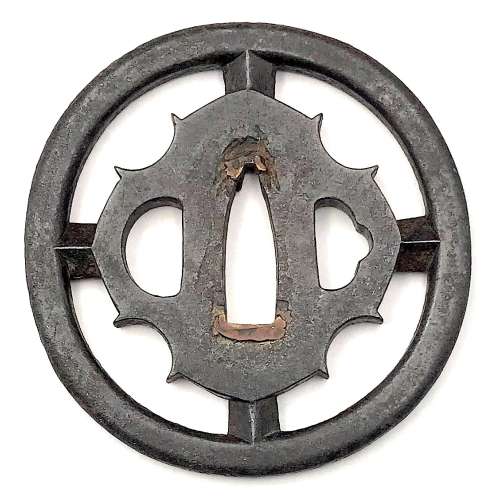 Iron tsuba of round form with slanting rays of light (shakoh) Christian motif (Jesuit's IHS symbol) in openwork (sukashi). Traditional description of this kind of design is called "tokei", or "clock gear". Edo period.
Iron tsuba of round form with slanting rays of light (shakoh) Christian motif (Jesuit's IHS symbol) in openwork (sukashi). Traditional description of this kind of design is called "tokei", or "clock gear". Edo period.Size: 77.7 x 76.1 x 6.7 mm.
For information regarding shakoh tsuba see article 'Kirishitan Ikenie Tsuba" by Fred Geyer at Kokusai Tosogu Kai; The 2nd International Convention & Exhibition, October 18-23, 2006, pp. 84-91.


